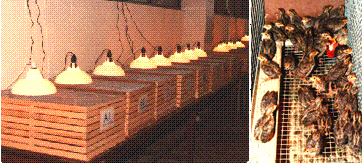Brooding Facilities:
Quail chicks can be brooded successfully in several types of commercial or game-bird battery brooders. When commercial chick battery brooders are used they must be modified to suit the small size of quail. The openings in the wire floor should be covered with a rough-surfaced paper during the first week to avoid damage to feet and legs. The wire sides of the brooder must be closed with either fine mesh or paper to prevent escape of the baby quails.

Heat:
Young coturnix chicks need extra heat to keep them warm until they are feathered. The proper brooding temperature for young birds is very important for successful management. The newly hatched quail chicks are transferred directly to the brooder from t he incubator. The heat to start with in the brooder should be only slightly lower than that of the incubator. They require a high temperature (37 ºC) at first and the temperature can be reduced 3 ºC each week until room temperature (28 ºC) is reached. Any brooder should afford an escape from under the heated area so the chicks can go and come as they wish. Feed and water are usually placed outside the heated hovering area. Thus, the chicks are forced to venture out from under the heat. This gives them needed exercise and accustoms them to lower temperature.
Feed:
Flat paper plates can be used as feeders for the first few days. Later, a 10 cm x 30 cm x 3 cm galvanized floor feeder with a 1.2 cm x 1.2 cm welded wire grill is placed over the opening to prevent feed wastage.
Water:
Water should be provided at all times. Care must be taken with small quails to prevent drowning in water troughs for the first two weeks. A pint canning jar with a glass or plastic fountain base works well. It should be modified by placing a donut shape d piece of hardware grill in the trough at the base. A shallow dish or pan filled with pebbles or marbles will also work. The chicks can drink between the marbles, but can not fall into the water. When chicks reach one week of age, the pebbles or wire protection can be removed with safety. It is important to provide clean water at all times. The water containers or troughs should be cleaned daily.


